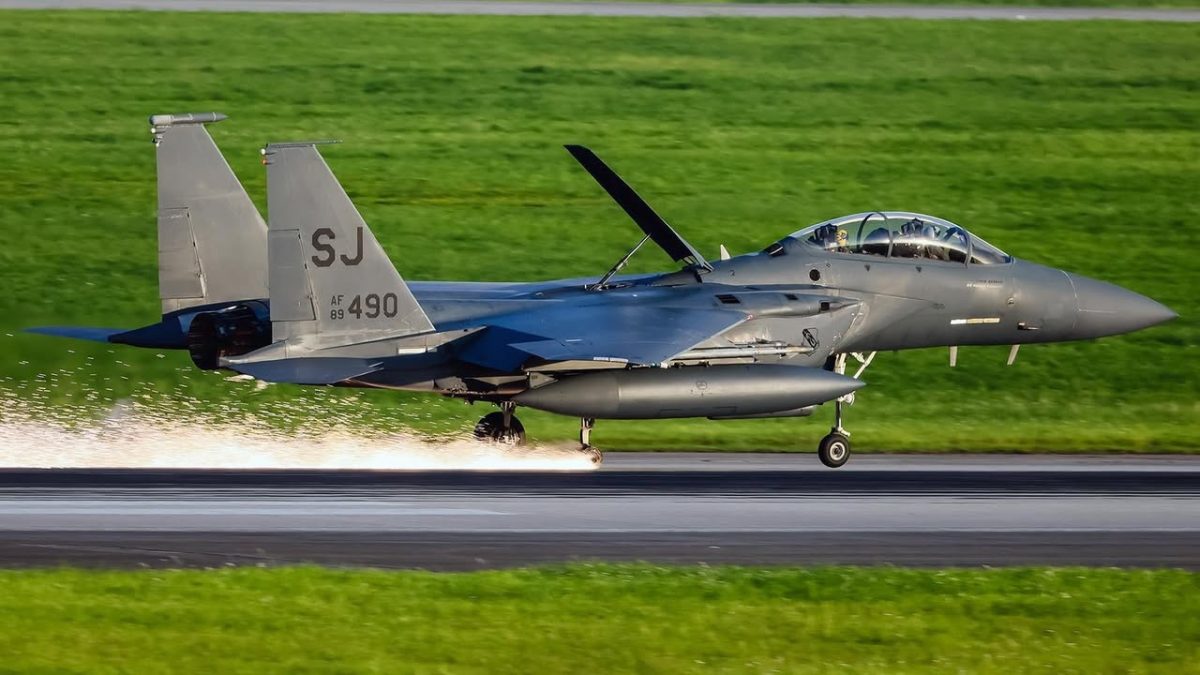In a terrifying incident, a US Air Force (USAF) F-15E Strike Eagle made an emergency landing at the Kadena Air Base, a forward US military facility in Japan, upon learning mid-flight that the fighter jet was missing a wheel.
The aircraft was flying from the military outpost in Diego Garcia to Kadena when the incident occurred.
“Today, Aug. 4, 2025, at approximately 6:40 p.m., a U.S. Air Force F-15E, deployed to Kadena Air Base, was involved in an aircraft incident after landing with a missing wheel. The two Airmen on board did not sustain any injuries,” the 18th Wing at Kadena said in a statement.
“The wheel was found to be missing in flight and was recovered on the flightline at U.S. Naval Support Facility Diego Garcia,” the Kadena-based air wing added. The aircraft in question was deployed to Diego Garcia earlier this year as part of a US military buildup to prepare for a military contingency in West Asia. Analysts said that the aircraft was perhaps homebound as part of a de-escalation by Washington.
The photos of the F-15E appeared online shortly after the incident was announced, showing the aircraft without a wheel, which had detached from the main landing gear.
The cause of the incident remains unknown and is currently under investigation. Moreover, the Kadena Air Base is inspecting all of its F-15E Strike Eagles in the wake of the incident.
The aircraft will resume flying status as soon as this safety inspection is complete. The Kadena runway where the wheelless fighter touched down has also been examined and is in perfect working order, according to the Kadena base.
PHOTOS: An Air Force F-15E Strike Eagle deployed to Kadena Air Base landed safely Monday evening after one of its wheels was discovered missing in flight.
📸: Hung-Hsin Hsu / Special to Stars and Stripes pic.twitter.com/NbHsVgtmO8
— Stars and Stripes (@starsandstripes) August 5, 2025
The F-15Es at the Kadena base are from the 336th Fighter Squadron at Seymour Johnson Air Force Base in North Carolina. They were deployed to the Okinawa base in 2023 when the USAF pulled out the older F-15 C/D fighters back to the US.
The US is also deploying the F-15EX, the latest and most advanced variant of the aircraft, to this key outpost.
Though the “missing wheel” incident was unprecedented, experts heaped praise on the aircrew.
“The way the aircrew handled the landing is a testament to their training and professionalism, and I want to thank the first responders and safety teams for being poised and ready to respond,” Brig. Gen. John Gallemore, commander of the 18th Wing at Kadena, said in a statement. “This event fortifies my confidence in Team Kadena’s ability to react to complex problems on a moment’s notice.”
As the Strike Eagle landed at Kadena without a wheel, it was reportedly seen with sparks and black smoke coming from the wheel’s hub. In the past, similar incidents required the aircraft to perform a belly landing to lower the hazards resulting from the imbalance and decreased controllability during the landing roll. However, the F-15E landed normally.
Typically, fighter pilots are trained for such scenarios, often using techniques like minimal descent rates or foam-covered runways to mitigate risks. In fact, as part of their training, pilots are made to practice techniques like “gear-up” or partial gear landings, where the pilot learns to manage the aircraft’s attitude and speed to minimize damage.

In any case, a missing wheel could be detrimental to a fighter jet. For one, a missing wheel can potentially disrupt the aircraft’s balance during landing, increasing the risk of veering off the runway, skidding, or tipping. This can lead to loss of control, especially at high landing speeds, and cause severe injuries to the pilot.
Moreover, the landing gear strut without a wheel could dig into the runway, causing damage to the gear assembly, airframe, or even the wing or fuselage. The sparks or friction caused by this could also ignite fuel leaks, which could further create an emergency by causing a fire.
A similar, but not identical incident, took place in 1983 when an Israeli F-15 Baz managed to land despite losing a wing after suffering a mid-air collision with an A-4 over the Negev desert. A detailed report on this incident can be read here.
The pilot of the aircraft, Nedivi, was later quoted in Bertie Simmond’s book “F-15 Eagle” as saying, “A normal approach is around 130 knots, but we made ours at around 250 to 260 knots, about twice that of a normal landing. As a result, I put down the F-15’s emergency arrestor hook, which engaged the cable around a third of the way down the runway. We hit that, but the speed we were going meant that the hook itself tore off the aircraft, and we eventually stopped 20 feet short of the barrier at the other end of the runway.” This was a historic milestone and one for the history books.
The F-15 has been involved in several such incidents, including those related to landing gear, over the years. However, the latest incident at Kadena comes after a string of fighter jet incidents at Kadena, which have fueled concern and anxiety among civilians.
Incidents At Kadena
Located in the center of the Indo-Pacific, Kadena is within 640 kilometers of Taiwan, 1287 kilometers of the Korean Peninsula, and close to important South China Sea locations. This makes it a vital forward-operating base for power projection, deterrence, and rapid response to regional conflicts, particularly involving China or North Korea.
Kadena hosts the US Air Force’s 18th Wing, the largest combat wing in the Air Force, operating a range of aircraft, including the F-15 Eagles, the F-15E Strike Eagles, the F-22 Raptor, F-35B Lightning II, and CV-22B Ospreys. The base has been witness to several USAF aircraft incidents in the past couple of years.
On December 1, 2022, a US Marine Corps F-35B Lightning II from Marine Fighter Attack Squadron (VMFA) 121 “Green Knights,” based at Marine Corps Air Station Iwakuni, Japan, suffered a nose gear collapse at Kadena Air Base, Okinawa, Japan.
The incident occurred after the aircraft made a precautionary landing due to suspected electrical problems. The nose of the aircraft broke while being towed on the taxiway, causing the aircraft’s nose to drop onto the ground.
The next big incident happened in November 2023 when a CV-22B Osprey crashed near Yakushima Island while en route to Kadena. All eight airmen aboard were killed in the accident, which was linked to a possible engine fire.
Japan grounded its Osprey fleet in the wake of the accident and requested a US flight suspension, amplifying concerns about aircraft safety. At the time, the locals in Okinawa cited the crash as evidence of risks posed by Kadena-based operations, straining US-Japan relations.
The next month, in December 2023, an F-35A Lightning II belonging to the US Air Force’s 356th Fighter Squadron landed at the base without a panel, which was probably lost over the Pacific Ocean. At the time, the spokesperson for the 18th Wing, 1st Lt. Robert Dabbs, stated that the aircraft was missing a hexagonal side panel that measured 18 by 12 inches and weighed roughly two pounds. “Expectations are the panel departed the aircraft over water,” Dabbs was quoted as saying.
In April 2024, an F-22A Raptor on rotational deployment to Japan from the 19th Fighter Squadron, 15th Wing, experienced a nose gear issue while being towed at Kadena Air Base.
The aircraft’s nose dropped to the ground during the towing process. Fortunately, no fire or injuries were reported. However, all these incidents demonstrated the innate precariousness associated with combat jet operations and forced a security rethink.
- Contact the author at sakshi.tiwari9555 (at) gmail.com
- Follow EurAsian Times on Google News




